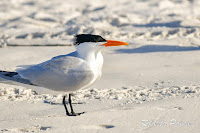ROYAL TERN
ROYAL TERN – (Thalasseus maximus) – (See images below)
DESCRIPTION: The Royal Tern has a black cap with a crest during breeding season. The cap covers the eye, which is black. Wings and back are light grey, the under parts white. Wing primaries are black. The orange bill is large relative to the head size, and pointed. Legs and feet are black. Outside the breeding season the cap is white with some black spots, but the black crest remains. Both sexes are similar. The bird measures around 50 cm (20 inches) long, which is large for a tern.
VOICE: https://www.xeno-canto.org/species/Thalasseus-maximus
NAME: This bird species is called ‘Royal’ for its impressive size and appearance. The name ‘Tern’ comes from Old English ‘Stearn’ to design that species. The Latin genus name ‘Thalasseus’ means ‘fisherman’ and ‘sea’, in reference to the bird feeding behavior. The species name ‘maximus’ means ‘the greatest’, in reference to the bird size.
HABITAT: Salt water along the coasts in sheltered bays, lagoons, mangroves or marshes. Found inland only after severe storms.
DIET: Opportunistic feeder – mostly small fish, also crustaceans and other small marine animals. Hunts prey by flying low over water surface with bill pointed down, and dives to seize it.
NESTING: Nests in colonies. Nest usually built in a scrape on the ground. One beige egg is laid, and parents are very defensive of their young. Chicks will gather in a ‘creche’, which can number in the hundreds. Parents are able to identify their own young in that crowd and will feed only their chick. Parental care extends for several months.
DISTRIBUTION: Breeding range extends along the USA east and west coasts down to those of South America except along the Andes, and also along the east coast of Africa. There is some partial migration from the northernmost USA coast range, but it is mostly a year-round resident.
Distribution map: https://en.wikipedia.org/wiki/Royal_tern#/media/File:New_Royal_Tern.png
ON PEI: Does not breed on Prince Edward Island. Observations ‘accidental’ so far. See note below on ‘Bird Vagrancy’.
CONSERVATION: Although the royal tern is currently listed as of ‘least concern’ by the IUCN, there are some threats to the nesting sites from flooding due to storm surges, as the latter become more severe due to climate change. The waters surrounding the nesting sites are also vulnerable to pesticides. Other threats are overfishing, depriving the royal tern of its sources of food, and water pollution from oil spills and chemicals.
NOTES: Terns are part of the same family as gulls.
Vagrancy: In biology this means an animal going way outside its normal range. For birds, this can happen when there are storms and they get blown off course. On other times, the bird simply wanders in a different direction than usual. Here’s an article about vagrancy in birds.
SIMILAR SPECIES: Caspian Tern, Common Tern
REFERENCES: https://en.wikipedia.org/wiki/Royal_tern
https://www.allaboutbirds.org/guide/Royal_Tern/id
https://www.audubon.org/field-guide/bird/royal-tern
http://identify.whatbird.com/obj/500/overview/Royal_Tern.aspx
http://www.oiseaux-birds.com/card-royal-tern.html
DESCRIPTION: The Royal Tern has a black cap with a crest during breeding season. The cap covers the eye, which is black. Wings and back are light grey, the under parts white. Wing primaries are black. The orange bill is large relative to the head size, and pointed. Legs and feet are black. Outside the breeding season the cap is white with some black spots, but the black crest remains. Both sexes are similar. The bird measures around 50 cm (20 inches) long, which is large for a tern.
VOICE: https://www.xeno-canto.org/species/Thalasseus-maximus
NAME: This bird species is called ‘Royal’ for its impressive size and appearance. The name ‘Tern’ comes from Old English ‘Stearn’ to design that species. The Latin genus name ‘Thalasseus’ means ‘fisherman’ and ‘sea’, in reference to the bird feeding behavior. The species name ‘maximus’ means ‘the greatest’, in reference to the bird size.
HABITAT: Salt water along the coasts in sheltered bays, lagoons, mangroves or marshes. Found inland only after severe storms.
DIET: Opportunistic feeder – mostly small fish, also crustaceans and other small marine animals. Hunts prey by flying low over water surface with bill pointed down, and dives to seize it.
NESTING: Nests in colonies. Nest usually built in a scrape on the ground. One beige egg is laid, and parents are very defensive of their young. Chicks will gather in a ‘creche’, which can number in the hundreds. Parents are able to identify their own young in that crowd and will feed only their chick. Parental care extends for several months.
DISTRIBUTION: Breeding range extends along the USA east and west coasts down to those of South America except along the Andes, and also along the east coast of Africa. There is some partial migration from the northernmost USA coast range, but it is mostly a year-round resident.
Distribution map: https://en.wikipedia.org/wiki/Royal_tern#/media/File:New_Royal_Tern.png
ON PEI: Does not breed on Prince Edward Island. Observations ‘accidental’ so far. See note below on ‘Bird Vagrancy’.
CONSERVATION: Although the royal tern is currently listed as of ‘least concern’ by the IUCN, there are some threats to the nesting sites from flooding due to storm surges, as the latter become more severe due to climate change. The waters surrounding the nesting sites are also vulnerable to pesticides. Other threats are overfishing, depriving the royal tern of its sources of food, and water pollution from oil spills and chemicals.
NOTES: Terns are part of the same family as gulls.
Vagrancy: In biology this means an animal going way outside its normal range. For birds, this can happen when there are storms and they get blown off course. On other times, the bird simply wanders in a different direction than usual. Here’s an article about vagrancy in birds.
SIMILAR SPECIES: Caspian Tern, Common Tern
REFERENCES: https://en.wikipedia.org/wiki/Royal_tern
https://www.allaboutbirds.org/guide/Royal_Tern/id
https://www.audubon.org/field-guide/bird/royal-tern
http://identify.whatbird.com/obj/500/overview/Royal_Tern.aspx
http://www.oiseaux-birds.com/card-royal-tern.html
 |
| Royal tern, FL, by Roberta Palmer |
 |
| Royal Tern calling, FL, by Roberta Palmer |
 |
| Royal terns, FL, by Roberta Palmer |
 |
| Royal tern prowley for prey, FL, by Roberta Palmer |
 |
| Royal tern diving for fish by Roberta Palmer |